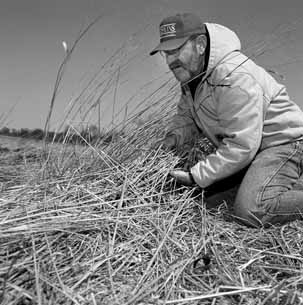 |
|
The Unburned Prairie by Chad Boutin
Fire can be nature's way of keeping ecological peace. Although it might seem an indiscriminate weapon, fire is the prairie's best defense against invasive plant species, which might otherwise overrun the native prairie ecosystem.
Ecologists have managed the nascent Fermilab prairie with fire for nearly a quarter-century. But a recent moratorium on controlled burns on Department of Energy property has threatened to release invading troops of non-native plants, hindering efforts to return the prairie to its pre-settlement state.
The tragic fires that swept the western United States last year incinerated thousands of acres at Los Alamos, Hanford, and Idaho National Laboratories. The extensive damage led DOE to impose a nationwide moratorium on controlled burning. However Fermilab prairie experts had hoped that the wetter conditions in Illinois would lead to a waiver on the no-burn policy for Fermilab.
"Los Alamos was a very serious situation," groundskeeper Bob Lootens said. "Over 400 homes burned there. But we have higher humidity and more water here than in the desert canyons. Fermilab has an excellent safety record with controlled burns."
In fact, on April 25 DOE granted a waiver for the spring season, through June 2001. While the waiver was welcome news, it may have come too late for the current season.
"We cannot burn much past mid-April, when ground-nesting birds start arriving," Lootens said. "We will need to get another waiver for the fall, when conditions again permit burning."
Centuries ago, prairie fires were a fact of life. Lightning strikes set the grass ablaze, and native Americans burned the prairie to keep their hunting grounds and transportation routes clear. Things changed when settlers arrived. To protect their property, farm owners would douse the blazes before they spread. By the time ecologists realized that fire was a part of nature's cycle, the prolonged lack of burning had allowed alien plant species to overrun the landscape.
"We have problems with plants like crown vetch, which is a European import," Walton said. "Nothing on this continent eats it. The reason we burn so frequently is to get plants like vetch off the prairie. They are hard to get rid of."
"With invasive plants, conversely, most of the biomass is above ground," Walton said. If you burn them often enough, you exhaust their resources to grow back."
Without periodic fire, old plant matter can cover the ground like thatch. A thorough blaze clears away this overgrowth, leaving room for the next generation of plants to sprout.
"Fire leaves the soil charred black, which absorbs more heat from the sun," Walton said. "Seeds are sensitive to soil temperatureóit tells them when to sprout. Without a burn, you lose that extra stimulus to their growth."
The lack of burning can have repercussions up the food chain. Animals as well as plants are adapted to prairie fires, and for local birds of prey, a fire smells like dinner.
"As soon as you start burning, the hawks show up," Walton explained. "Fire thrusts the field mice out into the open, and they run around like crazy. The raptors know a good meal when they see one."
Although fire may sound like the mice's worst enemy, they reproduce quickly, to compensate for the hawks' depredations. Walton believes regular burning has contributed to Fermilab's hawk and owl population, one of the densest in the state.
"The Chicago Academy of Sciences did a bird survey in 1989, and they were amazed at how many owls and red-tailed hawks we have," Walton said. "All these birds depend on mice for nourishment."
Because Fermilab's prairie is still relatively young, it requires more care than it will in the future. Walton and Lootens are hoping for permission to burn again this fall.
"We are trying to reconstruct not just a prairie, but a functioning prairie," Walton said. "Until the ecosystem is closer to equilibrium, we need to use fire to stay on top of it."
On the web:
|
| last modified 6/4/2001 by C. Hebert email Fermilab |
FRLsDFx9eyfrPXgV
 "Fermilab's prairie has not been burned for over a year now," said Fermilab ecologist Rod Walton. "If we don't burn soon, some of these unwanted species could begin to infiltrate."
"Fermilab's prairie has not been burned for over a year now," said Fermilab ecologist Rod Walton. "If we don't burn soon, some of these unwanted species could begin to infiltrate."
 With their deep root systems, native prairie species such as nodding wild onion and shooting star hide up to 70 percent of their biomass beneath the soil's surface. When their stalks burn, they retain enough energy below ground to sprout new leaves.
With their deep root systems, native prairie species such as nodding wild onion and shooting star hide up to 70 percent of their biomass beneath the soil's surface. When their stalks burn, they retain enough energy below ground to sprout new leaves.